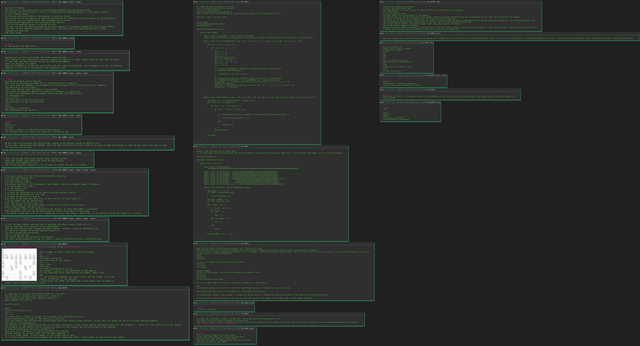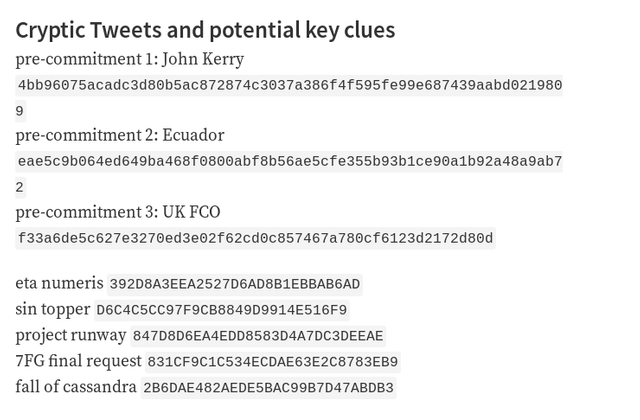VQC+++ postings Cracking RSA and ECC encryption?
Sounds like VQC+++ for Chris Curtis might have broken RSA. Well I might have known about this going on but I do believe we will see how this all fits together and if we can build this out. If this is true that means that bitcoin and a host of other encryption are in trouble. It seems wild to the untrained eye but I have seen in real life people have faked PGP Keys and this is right on the line with this understanding.
https://8ch.net/cbts/res/672.html#32349
In each cell of the grid ten entries shown for that cell.
The horizontal (column) coord comes first, which is e
The vertical (row) coord comes second, which is n
Each element in a cell is:
{e:n:d:x:a:b}
Where
(d+n)(d+n)-(x+n)(x+n) = c
ab = c
a+x = d
c# source code to follow to create the structure that will hold this grid.
Then an explanation of some of the features of the grid.
This will explain how infinite yet constructable sets that follow a known pattern, can be used as a means for use as a virtual quantum computer.
The grid is the superposition.
The collapse of that superposition will be two input parameters, d and e which can be calculated easily for all integers, c, where c is the difference of two squares.
All products of odd numbers and all products of pairs of even numbers are the difference of two squares.
We will be focusing on the first row where n=1
Each cell at n=1 contains the roots of products in a column.
Columns contain all products that have the same remainder e.
If c is a prime number, it will appear in one column exactly once.
If c is the product of two prime numbers that do not equal each other, c will appear in two cells of one column.
Each grid cell can be referenced by coordinates (e,n) e across and n down.
Since each grid cell that contains any elements will contain infinite elements, we can add a third variable t which indexes the elements.
E.g for the first column (containing all products c with a remainder 1 after subtracting the largest square) the first cell is at (1,1) where e=1 and n=1, the first three values of a are 1,5,13
At those cells b = 5,13,25 respectively
1x5=5
5x13=65
13x25=325
At (1,1) for elements t=1,2,3 then for a we can write
(1,1,1)=1
(1,1,2)=5
(1,1,3)=13
Another example:
At (4,1) for the second, third and fourth elements, the values of a are
(4,1,2)=4
(4,1,3)=10
(4,1,4)=20
You may recognise those numbers.
So, t is a index number that allows us to specify an element in a grid location.
Note:
All products (integers) c that are the sum of two squares appear (only) in columns where e=0,1,4,9,16,25,..
This demonstrates that the sum of two squares are closed under multiplication.
All Fermat primes (except 3) would appear in column one. We will discover something new about the conjecture that there are only five Fermat primes.
You may also note that the values of a and b at (1,1) are the related to the length of the longest side in right angled triangles.
This a higher of view of what we're working towards.
ab = c
dd+e = c
(d+n)(d+n)-(x+n)(x+n)
The difference of two squares.
a+x = d
xx+e = 2na
a+2x+2n=b
The grid coordinates are (e,n).
Any integer, c which is the difference of two squares…
e = the remainder after substracting the largest square (dd)
and
n = the difference between the square root d and the larger of the two squares (difference of two squares)
n also equals the number you would add to the square root to create a number exactly halfway between a and b
There are two loops in the program.
An inner loop and an outer loop.
All these loops do is create a series of integers which are the difference of two squares.
It is that simple.
1,3,4,5,7,8,9,11,12,13,15,..
All these numbers are the difference of two squares.
For the ones that are not the difference of two squares (these are odd when divided by two) you can divide by two to create the difference of two squares.
Therefore, the difference of two squares covers any integer you wish to factorise.
The private key in RSA is based on knowing the two factors of similar length that make up the product used to decrypt anything encrypted with the corresponding public key.
This virtual quantum computer will show you how to calculate the factors of a product of two primes.
The current fastest method is the general number fields sieve that searches for factors.
The virtual quantum computer calculates.
Whereas the general number field sieve is sub-exponential in the time taken to search, the virtual quantum computer is less than the natural logarithm in time to calculate.
A 4096bit RSA private key can be calculated in less than a second from the public key.
This is not finished yet.
RSA100 is just for use as an example.
I'll give you an example:
5x29=145
a=5
b=29
c=145
d=12
e=1
145 is the product of two primes.
Therefore it has two representations.
5x29
1x145
In the grid, it will appear at cells:
(1,5)
(1,61)
for 5x29, n=5 and n=61
Public RSA key = large composite number that follows a few rules, plus a public exponent (a fermat prime)
Private RSA key = factors of said number, fi(n) of that number (impossible to calculate with the head-banging algorithms of today)
fi(n) decodes a message in RSA. You can't get it without the private key.
d = (2 * fi(n) + 1) / e
d is decryption exponent, e is public exponent
encryption of message:
m^e mod N = c
m, message, N large composite, e public exponent, c encrypted message
decryption of message:
c^d mod N = m
d is private key (d is derived from the factors of N, the large composite)
The x axis is "i" from the C# code
The y axis is "j"
The hyperbola is the graph of all solutions to:
i^2 - j^2 = c
There are only two solutions which land on perfect integer pairs. For the example given, the number 145, the two points are (73,72) and (17,12). The first point is easily found through the simple factorization of 1*145 = 145. However, the other point is not so easily found without knowing the two prime factors.
Interesting note: at (73,72), the height straight up from that point to the asymptote (dotted blue line) is exactly 1, and always will be exactly one, because it is actually "a".
a = i - j
That means that the vertical height to the asymptote at (17,12) is the a we need, one of the two hidden prime factors. There may be a way to pattern the zero point or some other aspect of the graph in order to determine the proper green line connecting the two points, which could be converted to give the map points and all the parameters.

Grid Code
http://rextester.com/VNZ56795
https://pastebin.com/J5mrWkCk
RSA Challenge
http://rextester.com/QCJ73458
https://pastebin.com/BcuVjU0A
Firmate
youtube.com/watch?v=nUN4NDVIfVI

@gd work my dear @defango
Thanks for sharing
great contant dear.i like this post.
thanks,,
I do my best, what do you think about cracking RSA?
It had to happen eventually.
Another great post, upvoted and resteemed.
I do my best! Followed you
great post friend
Congratulations! This post has been upvoted from the communal account, @minnowsupport, by ${username} from the Minnow Support Project. It's a witness project run by aggroed, ausbitbank, teamsteem, theprophet0, someguy123, neoxian, followbtcnews/crimsonclad, and netuoso. The goal is to help Steemit grow by supporting Minnows and creating a social network. Please find us in the Peace, Abundance, and Liberty Network (PALnet) Discord Channel. It's a completely public and open space to all members of the Steemit community who voluntarily choose to be there.
If you would like to delegate to the Minnow Support Project you can do so by clicking on the following links: 50SP, 100SP, 250SP, 500SP, 1000SP, 5000SP. Be sure to leave at least 50SP undelegated on your account.
This post has received a 0.45 % upvote from @drotto thanks to: @banjo.
good work @defango

resteem